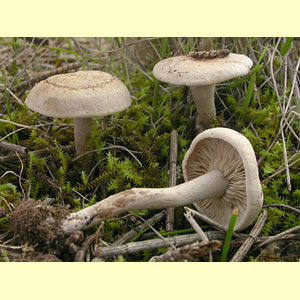
images/Clitopilus_morphogroup_Rhodocybe/Rhodocybe_reticulata4.jpg
Medium-sized agaric, growing on the ground or rarely on wood, with a pinkish brown spore print. Pileus pale, brown or grey, not viscid. Lamellae sinuate or notched, subdecurrent or decurrent. Stipe central, rarely excentric or lateral. Partial veil remnants absent. Spores angular in end view but not distinctly in side view, hyaline or pale, rarely brown, non-amyloid, warty; germ pore absent. Cheilocystidia present or absent. Lamellar trama regular. Pileipellis a cutis. Clamp connections absent (in all Australian species), rarely present.
Entoloma has spores that are angular in all views, and a wider range of fruit-body colours than in
Clitopilus morphogroup Rhodocybe. In the field the more robust species of morphogroup Rhodocybe are difficult to distinguish from
Lepista, but that genus has warty spores that are not angular in any view, and clamp connections are present. In
Hebeloma the pileus is not viscid, spores are pale to yellow-brown, warty and not angular, and clamp connections are present.
Eleven species belong to morphogroup Rhodocybe, most until recently placed in
Rhodocybe as a separate genus:
C. acerbus (=
R. amara),
C. conchatus,
C. fuligineus,
C. lateritius,
C. pallidogriseus,
C. pseudopiperitus,
C. radicatus,
C. reticulatus and
C. tasmanicus, with
R. cyathoidea and
R. gracilenta yet to be transferred into
Clitopilus.
W.A., S.A., Qld, N.S.W., Vic. and Tas. (and probably also N.T.).
In native forests.
On the ground, sometimes on bare ground (such as trackside banks or mounds of clay), or occasionally on wood.
Saprotrophic.
Baroni, T.J. (1981), A revision of the genus
Rhodocybe Maire (Agaricales),
Beih. Nova Hedwigia 67: 1–194. [
Description and
Microcharacters of
R. gracilenta]
Baroni, T.J. & Gates, G.M. (2006), New species and records of Rhodocybe (Entolomataceae, Agaricales) from Tasmania, Austral. Syst. Bot. 19: 343–358. [Description, Illustration and Microcharacters of C. acerbus (as Rhodocybe amara), C. fuligineus, C. lateritius, C. pallidogriseus, C. pseudopiperitus, C. reticulatus and C. tasmanicus (as Rhodocybe)]
Grgurinovic, C.A. (1997a), Larger Fungi of South Australia. The Botanic Gardens of Adelaide and State Herbarium and The Flora and Fauna of South Australia Handbooks Committee, Adelaide. [Description and Microcharacters of C. reticulatus and C. radicatus (as Rhodocybe)]
Horak, E. (1979b), Fungi agaricini Novaezelandiae VII. Rhodocybe Maire, New Zealand J. Bot. 17: 275–281. [Description, B&W Illustration and Microcharacters of C. fuligineus and eight other species from New Zealand (as Rhodocybe), along with Key]
Horak, E. (1979c), Notes on Rhodocybe Maire, Sydowia 31: 58–80. [Description and Microcharacters of C. radicatus, C. reticulatus (as Rhodocybe) and R. cyathoidea]
Noordeloos, M.E. & Gates, G.M. (2012), The Entolomataceae of Tasmania. Fungal Diversity Research Series, Volume 22. Springer, Dordrecht. [Illustration of C. conchatus, C. fuligineus, C. lateritius, C. pallidogriseus, C. pseudopiperitus and C. reticulatus, Key, B&W Illustration, Description and Microcharacters for these species and C. acerbus and C. tasmanicus]

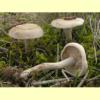
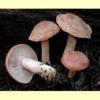
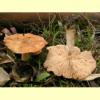
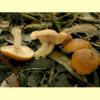
_AM_35_sml.jpg)
